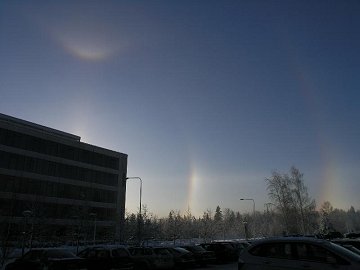 Did you sleep through the auroras of Dec. 14th? Next time get a wake-up call: Spaceweather PHONE.
Did you sleep through the auroras of Dec. 14th? Next time get a wake-up call: Spaceweather PHONE.
PHOTO-OP: A dark, magnetic filament that swirled around sunspot 940 a few days ago has unfurled, and now it stretches some 200,000 km across the face of the sun. This is a nice photo-op for amateur astronomers with solar telescopes.
images: from Robert Arnold on the Isle of Skye, Scotland; from John Candy of Whitley Bay, North Tyneside, UK; from Peter Paice of Belfast, Northern Ireland.
LOOKING FOR SATURN? It's right beside the Moon. Step outside tonight at sunset and look east. Just above the rising Moon lies Saturn, shining three times brighter than a 1st-magnitude star.

Above: Last night, Dan Bush took this picture of the full Moon rising over a farmhouse in Albany, Missouri. Photo details: Nikon D70, 200mm lens, f/5.
Got a telescope? Point it at Saturn. Even cheap department-store 'scopes reveal the planet's breathtaking rings: finder chart.
more images: from P-M Hedén of Vallentuna, Sweden; from Tunç Tezel of near Bolu, Turkey; from Elke Schulz of Stuttgart, Germany.
DIAMOND DUST: The place: Sweden. The temperature: -5o C. The air: Filled with ice crystals.
That was the situation on January 24th when Gote Flodqvist stepped into the parking lot of the Karolinska University Hospital. He looked up and beheld a sky filled with delicate arcs and pillars of light:

These are ice halos--a whole bunch of them--formed by sunlight shining though diamond dust ice crystals in the air. "Diamond dust crystals make some of the very best halo displays," says atmospheric optics expert Les Cowley. "When you see halos like these, always check the sky opposite the sun -- you could be surprised!"

